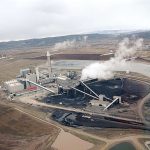Colorado snowpack at lowest point in 10 years as mixed winter season nears its end

John F. Russell/Steamboat Pilot & Today
After peaking in early April, snowpack levels in Colorado are continuing their sharp descent as the skiing season comes to a close.
Snowpack is measured by tracking the snow-water equivalent, which shows how much liquid water is held within the state’s snowfields. Following its progress through the winter and spring helps provide insight into the strength of the season’s runoff and what it means for the health of the state’s reservoirs and drought conditions.
As of Friday, April 25, statewide snowpack measurements stood at 66% of the 30-year median, according to data from the Natural Resources Conservation Service.
That’s the lowest point for this time of year since the 2014-15 water year. For every major river basin that reports snowpack data, levels are significantly below normal.
“It was a little bit of a warmer year and just not quite the amount of snow and storms you’d like to see for the state as a whole,” said National Weather Service meteorologist Aldis Strautins.
Still, some areas defied the statewide trend with levels that met or even exceeded normal. While early winter favored the southwestern part of the state, storms began to track in favor of the central and northern mountains, with those regions seeing more robust snowpack levels during the core of the winter season.
“As you start to get below (Interstate 70) and start heading south, it starts to get worse,” Strautins said. “We were well below normal in the San Juans and Four Corners area. … A lot of places have actually melted out down there that normally hold snow a little bit longer.”
Unlike the southwestern part of the state, the National Oceanic and Atmospheric Administration’s latest drought projection shows northern and central mountain areas are largely expected to be drought-free through the end of July.
In the Yampa-White-Little Snake water basin, which includes Routt County, snow water equivalent measurements stood at 75% of the 30-year median as of Friday.
The trend was somewhat in keeping with the La Niña pattern that developed heading into the winter season, a pattern typically characterized by more precipitous, cooler weather in the north and drier, warmer weather in the south.
La Niña occurs when surface temperatures in the equatorial Pacific Ocean off the coast of South America fall below average, pushing the jet stream north, while an El Nino pattern represents the opposite.
It’s too early for forecasters to know what pattern will develop next winter. In an April 25 blog post, OpenSnow meteorologist Sam Collentine wrote that “there is no strong preference for any category, although La Niña is favored over El Niño conditions.”
“When looking back at the previous La Niña winters for Colorado, it tends to be a mixed bag,” Collentine wrote. “Northern Colorado can be favored over Southern Colorado, but this isn’t always the case.”
Snow could return to the mountains next week, with storm conditions developing sometime on April 28 or 29 and another on May 1, according to another blog post by OpenSnow meteorologist Joel Gratz.
“Neither of next week’s storms will likely generate a lot of snow for a lot of locations, but the combination of the two systems will likely produce some accumulating snow at elevations near and above 9,000 feet,” Gratz wrote.
Weather conditions are, however, expected to be warmer and drier over the next month, with the National Oceanic and Atmospheric Administration projecting a heightened chance for above-normal temperatures and below-normal precipitation for western Colorado.

Support Local Journalism

Support Local Journalism
Readers around Steamboat and Routt County make the Steamboat Pilot & Today’s work possible. Your financial contribution supports our efforts to deliver quality, locally relevant journalism.
Now more than ever, your support is critical to help us keep our community informed about the evolving coronavirus pandemic and the impact it is having locally. Every contribution, however large or small, will make a difference.
Each donation will be used exclusively for the development and creation of increased news coverage.









